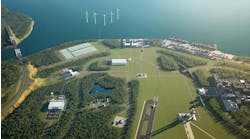National Instruments (NI) seems to be edging closer to compliance with the IEC 61131-3 programming standard by incorporating what it describes as New LabView function blocks for familiar functions based on IEC 61131-3 into LabView 8.6, the latest version of the graphical programming software released to coincide with this months NI Week annual user conference in Austin, Texas. Although LabView has always had its adherents in the industrial automation world, until recently NI has not seen compliance with IEC 61131-3 as necessary or even desirable. That position now seems to be under review however. As U.K. and Ireland marketing manager Ian Bell explained at the London preview of the new release in late July, Adoption of our package has got to the level where 61131 compliance has become important.
Whole application
Hitherto, said Bell, LabView has typically been used by developers to add higher-level control functionality to conventional PLC applications. However, he said, Were now being asked to take on the whole application, so that is becoming important.
Did that imply that LabView actually was being excluded from some industrial applications simply because of an inability to tick the IEC 61131-3 compliance box? I wouldnt say excluded, but . . . was the enigmatic response.
NI still appears to be holding itself aloof from the general run of industrial applications. However, SCADA and soft logic vendors who may have taken their eye off the ball while they grapple with the implications of MES need to be aware of the potential threat posed by an eventually fully IEC 61131-compliant LabView, particularly in applications lying at the interface between development and production and between scientific data acquisition and industrial automation. Recent LabView successes range from its inclusion in the newly introduced LEGO Education WeDo product targeting seven to eleven year olds to the CERN Large Hadron Collider, described as the most powerful instrument on earth.
Parallelism
That threat―or promise―could become increasingly significant as new technologies migrate from the scientific to the industrial arena. Three technologies in particular form the focus of the latest release of LabView perhaps the most significant of which is represented by further developments in its support for parallel programming for multicore processors. That issue had already been addressed in LabView 8.5, released in August 2007, but the new release takes the capability a stage further, responding not just to current processors with two or three cores, but to the larger devices Apples Steve Jobs was referring to when he observed that Nobody knows how to program those things.
To that end, LabView 8.6 includes more than 1,200 advanced analysis functions optimized to offer faster enhanced mathematical and signal processing on multicore systems in control and test applications. NI also claims that the new release allows control system engineers to execute simulation models in parallel up to five times faster without requiring code changes.
That theme of taking advantage of parallelism without recourse to specialist expertise also extends to LabViews support for FPGAs and for wireless. In the former case, engineers can use the LabView FPGA Module and FPGA-based commercial off-the-shelf (COTS) hardware such as NIs own CompactRIO to increase performance in measurement and control applications without having to develop familiarity with low-level hardware description languages or board-level design. It is also now possible to program CompactRIO-based PACs without having to program the FPGA separately.
Similarly with NIs approach to wireless, the aim is to allow existing users to add wireless without having to modify their existing applications; hence, the inclusion of support for wireless versions of NIs own data acquisition devices and of drivers for more than 20 third-party wireless sensors.
One typical application is the use of Wi-Fi devices to extend the range of measurements using existing code in such areas as noise and vibration measurement in the construction industry.
NI already claims that LabView is the worlds most popular data acquisition platform. Its very flexibility and, not least, its name perhaps make it less easy to classify as an industrial automation solution, but its rapidly expanding capabilities, and arguably NIs belated recognition of the importance to industrial users of complying with industry-recognized standards, is likely to see OEMs and integrators increasingly turning to LabView to solve complex automation challenges.
LabView and CompactRIO programmable automation controllers are being used by NI Alliance Partner CGM Engineering in systems to be used by engineers conducting structural health research on seven recently constructed mega-structures in China, including both of the main venues for this years Olympic Games, the Beijing National Stadium and the National Aquatics Center. The nine 64-channel and two 36-channel systems each contain multiple CompactRIO controllers that connect directly to accelerometers for vibration measurements and an external GPS receiver for inter-chassis synchronization.
Each system is encapsulated in a rugged NEMA enclosure and can be accessed from anywhere in the world via secure Internet connections. In addition to the Olympic venues, the systems are deployed in the 104-storey World Trade Center in Shanghai, the 66-storey Park Hyatt Hotel complex in Beijing, a 240-m concrete arch dam in Ertan, an 8266-m, cable-stayed bridge in Shan-Tou and the base-isolated CEA data center in Beijing. The data collected will be used to improve the structural integrity of future buildings and hence reduce the number of lives lost in catastrophic events.



